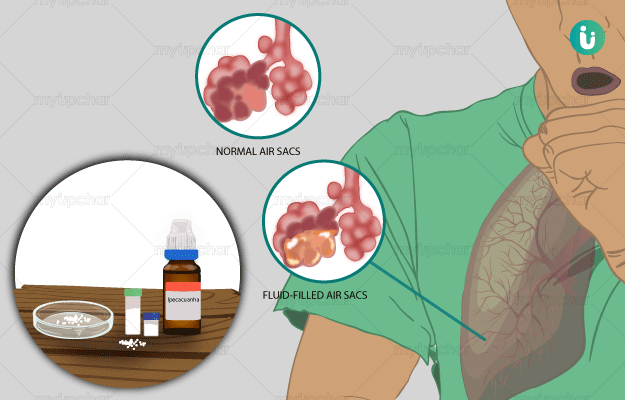Pneumonia is an infectious disease, which mainly affects the air sacs of lungs and has a characteristic inflammatory nature of progression. It is usually caused to due bacteria or virus but drug-induced pneumonia is not uncommon either. Occasionally, pneumonia may occur as a complication of flu. It is one of the most common causes of mortality related to hospital-borne infections.
Pneumonia symptoms may range from mild to severe and include cough, fever, chills, sputum production, breathing difficulty and chest pain. This disease may spread to healthy individuals via coughing, sneezing and, in some cases, even through touch. It can also spread from individuals who are infected but do not show any symptoms of the disease.
Ayurvedic treatment for pneumonia is based on the antibacterial activity of herbs and medicines and aims at removal of vitiated kapha from body. Ayurvedic herbs such as amalaki (Indian gooseberry), kutaja (kurchi), bhringraj (bhangra), tila (sesame), guduchi (giloy, heart-leaved moonseed), vasa (malabar nut) are used for the treatment of pneumonia. Ayurvedic medicines such as gorochanadi vati, sudarshan churna and sanjivani vati and procedures like langhana (fasting) and vamana (medical emesis) are also beneficial in pneumonia treatment.
- Ayurvedic view of pneumonia
- Ayurvedic treatment for pneumonia
- Ayurvedic herbs and medicines for pneumonia
- Dietary and lifestyle changes for pneumonia patient as per ayurveda
- How effective are ayurvedic medicines and treatments for pneumonia
- Side effects and risks of ayurvedic medicine and treatments for pneumonia
- Takeaway
Ayurvedic view of pneumonia
Pneumonia is called shwasanaka jwara (fever) in Ayurveda. Major signs and symptoms of shwasanaka jwara include high temperature accompanied by rigours, chest pain, and cough with production of thick, tenacious phlegm. Breathing is affected with increased expiration and inspiration of air, flaring of nostrils with difficulty in breathing. Pulse is seen to be soft, heavy and rapid. Other symptoms include sweating of the forehead, lassitude, weakness, delirium, and a rough and dirty feeling of the tongue. Immediate hospitalisation is recommended in case of extreme rapid pulse and breathing.
Fever associated with pneumonia is known to be kapha pradhan (kapha dominant). Vitiated kapha, along with ama (toxins), blocks various naadis (channels) in the body. This results in the spread of agni (fire) throughout the body, pushing heat towards skin and raising body temperature. Ayurvedic treatment of pneumonia aims at reduction of kapha dosha to promote healing and alleviate symptoms.
Ayurvedic treatment for pneumonia
- Langhana
- Langhana is the first line of treatment for accumulated ama and jwara.
- It is technically considered as upavasa (fasting), which brings about a state of apatarpana (reduced total calorie intake). It also induces a feeling of lightness.
- There are two types of langhana – nirahara (complete abstinence from food) and phalahara (eating only fruits). The type of procedure to be performed is decided on the basis of prakriti (constitution) of a person.
- Phalahara method is suitable for vata prakriti persons, while pitta and kapha type persons may undergo the nirahaar method.
- Langhana leads to digestion of ama, improves digestive fire, and increases clarity and sharpness of senses.
- Langhana therapy typically lasts for a period of 3 days and 3 nights. The best seasons to perform this procedure are hemanta and shishira (both occurring in winter).
- Vamana
- Vamana is a bio-purification procedure that eliminates toxic substances including excess or vitiated kapha and pitta dosha from body.
- It also removes ama and mucus from chest and naadis.
- Vamana is used for relieving jwara, lung conditions, asthma, cough and breathing difficulties.
- Herbs like pippali (long pepper) and madana phal (emetic nut tree) are used along with warm water or milk for the treatment of kapha-disorders.
- After vamana procedure, one is advised to wash their face, hands, and feet and inhale herbal smoke. A good rest post vamana is essential.
- Successful vamana results in calmness, clarity of mind along with improvement in disease symptoms.
Ayurvedic herbs and medicines for pneumonia
Ayurvedic herbs for pneumonia
- Amalaki
- This herb is well known for its immunity-enhancing and anti-ageing properties.
- Amla fruit is particularly indicated in the treatment of anaemia, asthma, diabetes, cold and chronic lung disease.
- Additionally, it is used for treating bleeding gums, hyperlipidemia, yeast infection and cancer.
- Amla is effective in relieving symptoms of lung inflammation associated with pneumonia.
- Amla hosts several antibacterial compounds, which aid in clearing out the infectious microbes responsible for pneumonia infection.
- Flavonoids and vitamin C in amalaki are potent antioxidants that prevent lung tissue damage associated with pneumonia.
- Kutaja
- Kutaja possesses astringent and antibacterial properties.
- It has been used in Ayurveda for the treatment of a number of diseases such as diarrhoea and pneumonia.
- Kutaja is an excellent antibacterial herb, which makes it effective in the treatment of pneumonia.
- Bhringraj
- This herb grows extensively throughout India.
- Leaves and roots of bhringraj have been used in Ayurvedic medicines for its antipyretic, rejuvenating and tonic properties.
- It also exhibits antibacterial, immunomodulatory, antioxidant and anti-hepatotoxic action.
- Together, these properties of bhringraj are useful in reducing the microbial activity associated with pneumonia and improving the overall health.
- Bhringraj is administered in the form of infusion, powder, decoction, medicated oil or ghee (clarified butter).
- Tila
- Seeds, oil and leaves of tila are used in ayurvedic medicine for various therapeutic purposes.
- It acts as a tonic and rejuvenator and aids in the treatment of diseases associated with the reproductive, excretory, urinary and respiratory systems.
- Tila helps treat pneumonia by inhibiting the action of microorganisms associated with this infection.
- Guduchi
- Guduchi is one of the most widely used antipyretic and immunomodulatory herbs in traditional and Ayurvedic medicines.
- Its also possesses, anti-inflammatory, and antioxidant activities, which are hlpful in the treatment of pneumonia.
- Guduchi is administered as a svarasa (juice), at a dose of 10 mL daily along with honey or pippali churna in order to reduce jwara associated with pneumonia.
- Vasa
- Vasa is used treatment of diseases associated with the circulatory, respiratory and nervous systems.
- It is known as a primary respiratory herb, relieving symptoms of cough, kapha disorders, bronchitis, flu and asthma.
- Vasa is administered along with sugar and honey for the treatment of jwara.
Ayurvedic medicines for pneumonia
- Gorochanadi vati
- This formulation is prepared from fresh adraka (ginger), kalamegha (green chirayta), horns of goat and deer, processed gold and galena.
- It is mainly recommended for the treatment of chronic fever, intermittent fever and respiratory disorders.
- Gorochanadi vati is genreally administered with honey twice daily. It is recommended to consume this preparation one hour before meals.
- Sanjivani vati
- This is one of the most commonly used herbal formulations.
- It consists of vidanga (false black pepper), shunthi (dried ginger), pippali, haritaki (chebulic myrobalan), vibhitaki (belleric myrobalan), amalaki, vacha (calamus), guduchi, shuddha bhallataka (pure Indian nut tree) and shuddha vatsanabha (pure Indian aconite).
- Sanjivani vati has deepana (appetising), pachana (digestive), vata-anulomana (vata-regulating), krimighna (worm-destroying), jwaraghna (fever destroying) and vishaghna (poison-removing) properties.
- It is typically administered with honey for the treatment of pneumonia.
- Sudarshan churna
- Powdered form of this medication is specifically indicated for the treatment of fever.
- It is an Ayurvedic formulation made of 48 herbs, with chirayata (bitterstick) as the primary herb.
- Sudarshan churna is best taken with cold water and is hghly beneficial in the treatment of pneumonia.
As treatments vary according to numerous factors and an individual’s prakriti, consult a qualified Ayurvedic doctor for the appropriate medications and treatments for your specific complaints.
Dietary and lifestyle changes for pneumonia patient as per ayurveda
Do’s
- Add cereals like old sali type of rice, gruel, yava (barley), daliya (porridge), and pulses like mudga (green gram) and masura (red lentils) in your daily diet.
- Fruits and vegetables like paravala (pointed gourd), karavellaka (bitter gourd), shigru (drumstick), guduchi, jivanti (leptadenia), grapes and pomegranates should be consumed.
- Light food and rest are recommended to ensure effective treatment and complete recovery.
Don’ts
- Do not consume chickpeas.
- Sesame, junk foods, and meals that cause distension of stomach and acidity should be avoided.
- One should take care to avoid contaminated water at all costs.
- Do not suppress natural urges like urinating and emptying bowels.
- Avoid physical exercises, sleeping during the day and eating frequently.
How effective are ayurvedic medicines and treatments for pneumonia
A study was conducted to assess the protective efficacy of amalaki against the pneumonia-causing bacteria, Klebsiella pneumoniae. It reports of significant reduction in bacterial colonisation of lung tissue along with increased phagocytic activity with the regular use of amlaki.
Another study reports of the antibacterial activity of the flower extract of kutaja, demonstrating the efficiency of this herb in inhibiting the growth of Klebsiella pneumoniae.
According to a study published in the International Journal of Pharmaceutical Sciences, a polyherbal formulation, with bhringraj extracts as one of its major ingredients is effective in suppressing Klebsiella pneumoniae growth and can thus be used in the treatment of pneumonia.
Side effects and risks of ayurvedic medicine and treatments for pneumonia
Ayurvedic therapies should be performed only after consulting a physician. Although herbs and treatment procedures have no specific side effects, it is necessary to take certain precautionary measures to prevent unwanted side effects from improper dosage. Mentioned below are few such side effects of ayurvedic medicines and treatments.
- Langhana and vamana treatment procedures are contraindicated in persons who have a vata-dominant prakriti.
- Vamana is not recommended in children, elderly and pregnant women. It should be avoided in persons with weakness, wounds, heart problems and hypertension. Vamana should not be performed in those with strong digestive fire, fatigue, constipation or gastrointestinal disorders.
- Amalaki can cause acute diarrhoea in persons with pitta dosha.
- Bhringraj should be taken with caution as it has the potential to cause severe chills.
- Large doses of tila may cause abortion, obesity and increased pitta.
Takeaway
Pneumonia is one of the major causes of serious illness and mortality worldwide. It is a lung infection with an inflammatory course of nature. Ayurveda aims at treating the kapha-dominant jwara associated with pneumonia and accumulated ama with herbs, herbal formulations and necessary therapeutic procedures. Antibacterial and antipyretic properties of herbs are what make the ayurvedic treatment of pneumonia effective. Along with medicines and treatment, certain dietary modifications along and adequate rest ensures a quick recovery.
Find Ayurvedic Doctor in cities
Doctors for Ayurvedic medicine, treatment and remedies for Pneumonia

Dr. Ayush Bansal
Ayurveda
2 Years of Experience

Dr. Megha Sugandh
Ayurveda
6 Years of Experience

Dr. Nadeem
Ayurveda
3 Years of Experience

Dr.Ashok Pipaliya
Ayurveda
12 Years of Experience
References
- Burke A. Pneumonia Essentials 2010. Cunha Jones & Bartlett Publishers, 22-Oct-2010 - Medical
- National Health Portal [Internet] India; Pneumonia.
- American Lung Association [Internet]: Chicago, Illinois. Learn About Pneumonia.
- A. Saini,S. Sharma,S. Chhibber. Protective efficacy of Emblica officinalis against Klebsiella pneumoniae induced pneumonia in mice. Indian J Med Res 128, August 2008, pp 188-193.
- Sahrawat. Antibacterial activity of Holarrhena pubescens (Kurchi) Flower against Gram negative Bacterial strains. Vegetos- An International Journal of Plant Research. 31. 80. 10.5958/2229-4473.2018.00011.3. 2018
- C. S. Barik et al. The efficacy of herbs against Klebsiella pneumoniae with special reference to polyherbal formulation: An update . Pharma Science Monitor 5(3) Supl-1, Jul-Sep 2014.
- Central Council for Research in Ayurvedic Sciences [Internet]: National Institute of Indian Medical Heritage; Āmasya Vrana (Anna-Drava Śula Evam Parinama Śula).
- Dr. Praveenkumar H Bagali,Dr. A.S.Prashanth. Clinical Application Of Langhana. Paryeshana International Journal of Ayurvedic Research VOLUME-II ISSUE –V May-June-2018 .
- Nishant Singh. Panchakarma: Cleaning and Rejuvenation Therapy for Curing the Diseases . Journal of Pharmacognosy and Phytochemistry Vol. 1 No. 2 2012
- Upadhyay AK et al. Tinospora cordifolia (Willd.) Hook. f. and Thoms. (Guduchi) - validation of the Ayurvedic pharmacology through experimental and clinical studies. Int J Ayurveda Res. 2010 Apr-Jun;1(2):112-21. PMID: 20814526













